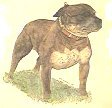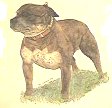
Introduction to
Genetics

The traits and characteristics that make organisms more adept at coping with their
particular lifestyles are usually inherited by the next generation. Genetics is the study
of how traits or characteristics are inherited. For the purposes of the dog breeder
genetics is basically understanding probabilities - if you can understand racing odds you
can understand the basics of genetics. To avoid confusion or misleading statements I will
try to use actual evidence from genetic experiments (e.g. Mendel and his experiments on
pea plants) rather than hypothetical examples which may be misleading.
The first subject to tackle when trying to understand heredity is simple Mendelian genetics (named after Gregor Mendel, 1822-1884), which relates to the study of characters determined by single hereditary factors with effects large enough to be easily recognised (e.g. height of pea plants). Mendel was an Austrian monk who experimented on peas, his findings (published in 1865) gave us Mendel's laws which deal with the basic mechanism of inheritance. Mendel's first law (of segregation) states that every somatic cell of an individual carries a pair (one from each parent) of hereditary units for each character and that during meiosis1 the pairs separate so that each gamete (germ cell, e.g. sperm) contains one unit of each pair. Mendel's second law (of independent assortment) states that the separation of the units of each pair is not influenced by that of any other unlinked pair, i.e. inheritance is usually random.
Fusion of male and female germ cells produces a zygote which contains pairs of heredity units (or genes - one from each parent). If the pair of hereditary units are the same then they are called homozygous, this means that even with random selection the same character is passed from generation to generation (unless mutation occurs). If the pair are different they are heterozygous.
The pairs of hereditary units which define a species are always homozygous, similarly, the hereditary units which define a breed of dog are also homozygous. This means that dogs of a particular breed will always breed true as a large proportion of homozygous pairs exist within each breed. However, when compared to the whole genome, the proportion of homozygous pairs which define a breed is small. Remember, there is less than a 5% difference between the genome of a human and that of a chimpanzee, so the proportion of the genome that represents variation within the same species is going to be much smaller than 5%. It is the variable (heterozygous) pairs that usually account for variation within a breed. However, this still leaves much room for variation since there are approximately 3 billion base pairs in the mammalian genome.
What is a breed?
To breed true to type each breed must have been developed by close breeding and inbreeding
among a small group of ancestors, either through many generations by selecting
characteristics from a more variable population, or through intensely selecting from a
very small population over relatively few generations. This is because breeding closely
related stock increases the chance that identical hereditary units from a common ancestor
will be passed from one generation to the next. Through inbreeding and close breeding a
desirable recessive trait is more likely to be expressed since a recessive gene can be
masked by a dominant gene in a heterozygous population. This is why linebreeding (a less
intense form of close breeding) increases the chance of having homozygous offspring and
fixes desirable breed traits that have been selected for. To all intents and purposes,
inbreeding does not create undesirable traits, but it can increase the expression of those
which are already in the heterozygous population.
Notes
1) A type of cell division that ultimately leads to the production of sperm in males and eggs in females.